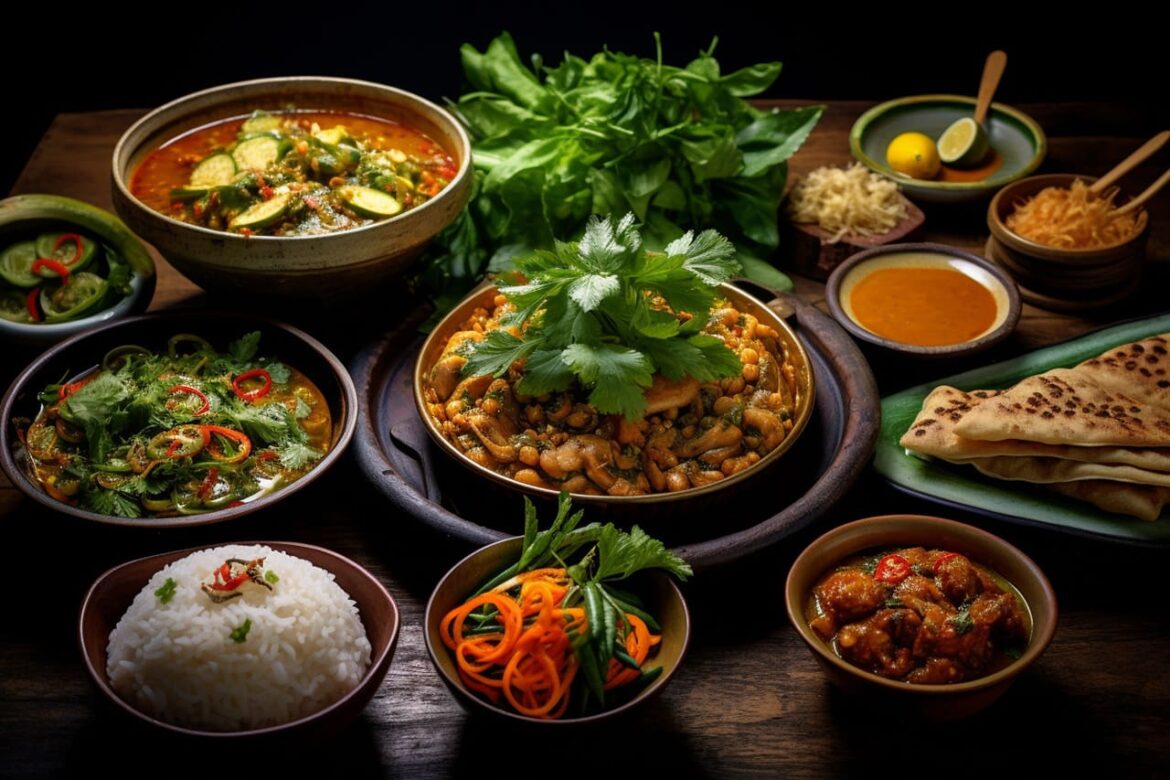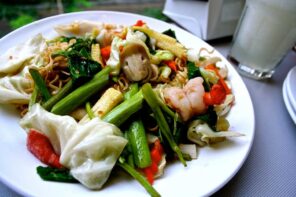Thai cuisine is a tapestry woven with history, tradition, and vibrant flavors. Known for its balance of four essential flavors—sweet, sour, spicy, and salty—Thai food offers a sensory experience that is both complex and deeply satisfying. This article aims to guide you through the labyrinth of popular Thai food dishes, from the bustling streets of Bangkok to the serene beaches of Phuket. Whether you’re a seasoned foodie or a curious traveler, this gastronomic journey through Thailand’s culinary landscape will whet your appetite.
Table of Contents
The Four Pillars of Thai Cuisine
Understanding Thai food requires an introduction to its four foundational flavors: sweet, sour, spicy, and salty. These are masterfully combined in varying ratios to create dishes that sing with complexity and depth.
Sweet
- Sugar: Often used in the form of palm sugar, it adds a caramel-like richness.
- Fruits: Mango, lychee, and pineapple are popular choices to introduce natural sweetness.
Sour
- Tamarind: A popular souring agent, used in dishes like Pad Thai.
- Lime: Freshly squeezed lime juice is often added just before serving for a zesty kick.
Spicy
- Chilies: Red and green Thai chilies bring heat, which can range from mild to extremely spicy.
- Curry Pastes: These are blends of chilies and spices, foundational in Thai curries.
Salty
- Fish Sauce: A fermented condiment that adds depth and umami.
- Soy Sauce: Used less frequently than fish sauce but still present in certain dishes.
Understanding these components will not only deepen your appreciation for Thai food but also help you navigate menus and street food stalls more effectively. The magic of Thai cuisine lies in the artful balance of these flavors, creating a harmonious dish where no single element overshadows the other.
The Unmissable: Pad Thai
When you think of Thai food, the dish that probably comes to mind is Pad Thai. This stir-fried noodle dish is the epitome of Thai street food but is also frequently found in restaurants, both in Thailand and around the world. Pad Thai encapsulates the essence of Thai cuisine by harmonizing the four fundamental flavors.
Ingredients and Variations
- Rice Noodles: The base of the dish, usually flat and thin.
- Proteins: Common choices include shrimp, chicken, or tofu for a vegetarian option.
- Vegetables: Bean sprouts and green onions add crunch and freshness.
- Egg: Scrambled into the dish for added texture and flavor.
Flavor Components
- Tamarind Paste: Provides the signature sour note.
- Fish Sauce: Adds the salty and umami elements.
- Palm Sugar: Balances the dish with its sweetness.
- Chilies: Introduce heat, tailored to your tolerance level.
How to Enjoy
Eating Pad Thai is almost as fun as saying it. Use a fork and spoon, or chopsticks if you’re up for the challenge. Lime wedges are often served on the side, giving you the choice to add an extra burst of sourness right before you dig in.
Whether you’re enjoying it at a high-end restaurant or a humble street stall, Pad Thai offers a culinary experience that is both comforting and exotic, simple yet complex. This iconic dish serves as a perfect introduction to the wonders of Thai cuisine, captivating first-timers and satisfying long-time enthusiasts alike.
The Quintessential Soup: Tom Yum
If Pad Thai is the face of Thai main courses, then Tom Yum is undoubtedly the star of Thai soups. This hot and sour delight is a culinary journey within a bowl, representing everything that’s cherished about Thai food—complexity of flavors, freshness of ingredients, and the inimitable touch of exotic spices.
Key Ingredients
- Shrimp or Chicken: The protein that gives body to the soup.
- Lemongrass: For that citrusy undertone.
- Galangal: Similar to ginger but more nuanced.
- Kaffir Lime Leaves: Provides a unique, aromatic citrus note.
Flavor Wheel
- Sour: Comes mainly from lime juice or sometimes tamarind.
- Spicy: Red chilies or chili paste bring the heat.
- Salty and Umami: Fish sauce and soy sauce add depth.
- Herbal: The unique trio of lemongrass, galangal, and kaffir lime leaves.
How to Savor
Tom Yum is best enjoyed piping hot. The steam carrying the aroma of the spices prepares your senses for the first spoonful. It is commonly served with a side of jasmine rice or sometimes rice noodles. As you sip, you’ll notice how the disparate flavors merge to form a harmonious whole. The soup doesn’t just please the palate but also has a warming, almost therapeutic effect, especially welcome if you’re navigating the spicier corners of Thai cuisine.
The universality of Tom Yum lies in its flexibility. It has multiple variants—Tom Yum Goong with shrimp, Tom Yum Gai with chicken, and even vegetarian versions. Each version retains the basic essence of Tom Yum while offering a slightly different experience, making it an endlessly enjoyable dish that you’ll want to return to time and time again.
A Taste of the Sea: Som Tum
Som Tum, or Thai green papaya salad, is a delightful showcase of Thailand’s coastal abundance. While seafood isn’t a mandatory component, variations of the dish often feature shrimp or crab, offering an oceanic touch to an otherwise earthy offering.
Key Ingredients
- Green Papaya: Grated into thin strips, the unripe papaya serves as the base.
- Chilies: For a necessary kick.
- Fish Sauce: Adds the umami and saltiness.
- Lime: For a tangy bite.
- Tomatoes and Green Beans: For additional texture and color.
Flavor Spectrum
- Spicy: Thanks to the chilies, which you can adjust to your heat tolerance.
- Sour: Lime juice plays a pivotal role.
- Sweet: Palm sugar balances out the spicy and sour notes.
- Umami: Fish sauce or shrimp paste for that extra depth of flavor.
How to Enjoy
Som Tum is traditionally pounded in a mortar and pestle, which helps to combine the flavors and slightly bruise the green papaya, making it more receptive to the dressing. It’s a refreshing dish, ideal for hot climates and spicy food. A perfect side dish, Som Tum pairs exceptionally well with grilled meats and sticky rice.
The salad is not just a favorite in coastal areas but also enjoys widespread popularity across Thailand and beyond. Each region has its take, adding ingredients like tamarind, peanuts, or even fermented fish, resulting in a wide array of Som Tums to suit every palate. This dish is a brilliant example of how Thai cuisine masters the art of balancing diverse flavors and textures within a single plate.
Curries to Remember: Green Curry
Green Curry, known as “Kaeng Khiao Wan” in Thai, is a rich and creamy dish that leaves a lasting impression. Originating from Central Thailand, this curry stands out for its vibrant color and intricate flavors.
Key Ingredients
- Green Curry Paste: The soul of the dish, made from green chilies, lemongrass, and various aromatic herbs.
- Coconut Milk: Lends a creamy texture and sweetness.
- Protein: Typically chicken, though pork, beef, or tofu can also be used.
- Vegetables: Thai eggplant, bamboo shoots, or bell peppers for a nutritious punch.
Flavor Profile
- Spicy: The green chilies give it a unique but not overpowering heat.
- Sweet: The natural sweetness of coconut milk.
- Herbal: A complex mix of spices and herbs like basil and coriander.
How to Enjoy
Served hot, the green curry pairs beautifully with steamed jasmine rice. In Thailand, you’ll often find it accompanied by a plate of vegetables like cucumber and long beans, which serve as a palate cleanser.
Green Curry is versatile; don’t hesitate to ask for your preferred level of spiciness or choose alternative proteins and vegetables. In high-end Thai restaurants, you might find luxurious versions featuring duck or seafood.
While Thai green curry has gained international acclaim, the dish in Thailand remains unique, primarily due to the freshness of locally-sourced ingredients. The vibrant green hue and the aroma of fresh herbs make this dish a visual and olfactory delight, promising a flavorful experience that encompasses the essence of Thai cooking.
The Royal Dish: Massaman Curry
Massaman Curry is a rich, creamy dish that represents Thai food’s multi-layered complexity. It’s not just a curry; it’s a harmonious blend of flavors, proving that Thai cuisine is far from one-dimensional.
Key Ingredients
- Meat: Often beef, but chicken and pork are also used.
- Coconut Milk: For the creamy texture.
- Potatoes: A filling component that absorbs the flavors well.
- Massaman Curry Paste: A blend of spices like cinnamon, cloves, cumin, and more.
- Peanuts: For added texture and flavor.
Flavor Profile
- Sweet: Courtesy of the coconut milk and a hint of sugar.
- Savory: The meat and curry paste offer deep flavors.
- Spicy: It’s a mild heat that builds as you eat.
- Complex: The blend of spices makes it multi-layered.
How to Enjoy
Massaman curry is typically served with jasmine rice, and the two complement each other perfectly. The rice absorbs the curry’s rich flavors, making each bite a new experience.
Interestingly, Massaman Curry has Middle Eastern influences, seen in the use of spices like cinnamon and cloves, a reminder of Thailand’s position as a crossroads for various cultures and cuisines.
The making of Massaman Curry is somewhat of an art form. The balance of spices, the preparation of the curry paste, and the slow cooking of meat make it a dish that requires both time and skill. In Thailand, Massaman Curry is often associated with special occasions and is a popular dish among Thai royalty, adding a layer of cultural richness to its already intricate flavors.
Massaman Curry has received international acclaim, and it’s easy to see why. With its blend of flavors and aromas, this curry doesn’t just satisfy your taste buds; it takes them on a journey.
Seafood Sensation: Tom Yum Goong
Tom Yum Goong captures the essence of Thai cuisine in a single bowl. This seafood soup showcases Thailand’s abundant coastal offerings while balancing hot, sour, salty, and sweet flavors.
Key Ingredients
- Shrimp: The star of the dish.
- Lemongrass: For that citrusy tang.
- Kaffir Lime Leaves: Adds a unique aromatic note.
- Galangal: A root similar to ginger, but with its own distinct flavor.
- Chilies: For the heat.
Flavor Profile
- Sour: The lime juice provides a tangy kick.
- Spicy: Thai bird chilies offer a significant heat level.
- Savory: Shrimp and fish sauce add depth.
- Herbaceous: The herbs infuse the soup with complex aromas.
How to Enjoy
Tom Yum Goong is best enjoyed piping hot, usually as a starter to awaken the palate for the dishes to follow. It’s also a great dish to share; its aromatic qualities are universally appealing, making it a crowd-pleaser.
Tom Yum Goong has medicinal qualities as well. The combination of herbs like lemongrass and galangal are thought to have health benefits, making this dish not just delicious but also nourishing.
In Thailand, you’ll find variations of Tom Yum with different types of seafood or even chicken. But the shrimp version—Tom Yum Goong—is the most iconic. Each spoonful offers a burst of flavors and a variety of textures, from the succulent shrimp to the chewy mushrooms often found in the dish.
If there’s one dish that personifies the complexity and balance in Thai cuisine, it’s Tom Yum Goong. Its vibrant flavors and comforting warmth make it more than just a soup; it’s an experience in a bowl.
Savoring the Tastes of Thailand
Thai cuisine is a feast for the senses, offering an array of dishes that are as vibrant in flavor as they are in presentation. From the spicy kick of Green Curry to the comforting goodness of Pad Thai and the sweet delight of Mango Sticky Rice, there’s something for everyone. What makes Thai food truly exceptional is the meticulous balance of flavors—sweet, spicy, sour, and salty—achieving a harmony that is both satisfying and exhilarating.
This exploration into popular Thai dishes only scratches the surface of the culinary landscape you can experience. Each dish is a gateway to understanding Thai culture, traditions, and the local way of life. Whether you’re dining in a high-end restaurant or grabbing a quick bite from a street vendor, the essence of Thai cuisine remains constant: flavorful, fresh, and irresistibly delicious.
So the next time you find yourself contemplating what to eat, remember that the world of Thai cuisine offers an adventure for your taste buds, one that’s as diverse and complex as the country itself. Happy eating!




